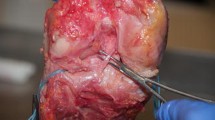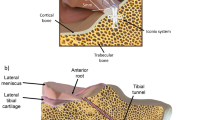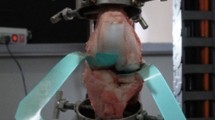Abstract
Purpose
The purposes of this study were to evaluate the effect on tibiofemoral contact mechanics of repair of the posterior root of the medial meniscus and the effect of meniscal allograft transplantation (MAT) with medial collateral ligament (MCL) release at different flexion angles.
Methods
Ten fresh-frozen human cadaveric knees (five pairs) were used. A digital pressure sensor was inserted by capsulotomy, and experiments were performed serially under the following six conditions, that is, with an intact medial meniscus (normal controls), with a root tear, after root repair, after total meniscectomy, after MAT, and after MAT plus MCL release. During each experiment, knees were positioned at 0°, 30°, 60°, and 90° of flexion, and peak pressure (kPa) and contact area (cm2) were measured.
Results
At 0° of flexion, contact pressure did not differ among the six experimental settings. However, at 30° and 60° of flexion, contact pressure differed significantly between root tear and root repair specimens (p = 0.04 and 0.03, respectively), and between total meniscectomy and MAT specimens (p = 0.02 and 0.03, respectively). On the other hand, mean contact pressures were different between normal (476.7 ± 473.1 and 573.3 ± 479.1 kPa) and root repair (575.7 ± 357.8 and 598.6 ± 415.8), and between normal and MAT (635.7 ± 437.4 and 674.3 ± 533.2). At 0°, 30°, 60°, and 90° of flexion, contact areas differed significantly between normal and total meniscectomy specimens (p = 0.02, 0.01, 0.02, and 0.02, respectively), and between MAT and total meniscectomy specimens (p = 0.03, 0.02, 0.02, and 0.03, respectively). Contact areas differed significantly between root tear and root repair specimens at 60° of flexion (p = 0.04), and between normal control and root repair specimens at 60° and 90° of flexion (p = 0.03 and 0.04, respectively). The effects of MAT plus MCL release on contact mechanics were not different from the effects of MAT alone (n.s.).
Conclusions
Both meniscal root repair and transplantation of meniscus improved contact mechanics, but it did not appear that repair of the meniscal root or transplantation of meniscus restores the biomechanical function back to normal level. The MAT plus MCL release was similar to those after MAT alone. Therefore, it is better to preserve meniscus and MCL release could be done during the MAT.

Similar content being viewed by others
References
Ahn JH, Lee YS, Chang JY, Chang MJ, Eun SS, Kim SM (2009) Arthroscopic all inside repair of the lateral meniscus root tear. Knee 16:77–80
Ahn JH, Lee YS, Yoo JC, Chang MJ, Koh KH, Kim MH (2010) Clinical and second-look arthroscopic evaluation of repaired medial meniscus in anterior cruciate ligament-reconstructed knees. Am J Sports Med 38:472–477
Allaire R, Muriuki M, Gilbertson L, Harner CD (2008) Biomechanical consequences of a tear of the posterior root of the medial meniscus. Similar to total meniscectomy. J Bone Joint Surg Am 90:1922–1931
Baker BE, Peckham AC, Pupparo F, Sanborn JC (1985) Review of meniscal injury and associated sports. Am J Sports Med 13:1–4
Bin SI, Kim JM, Shin SJ (2004) Radial tears of the posterior horn of the medial meniscus. Arthroscopy 20:373–378
Brophy RH, Cottrell J, Rodeo SA, Wright TM, Warren RF, Maher SA (2010) Implantation of a synthetic meniscal scaffold improves joint contact mechanics in a partial meniscectomy cadaver model. J Biomed Mater Res A 92:1154–1161
Harner CD, Mauro CS, Lesniak BP, Romanowski JR (2009) Biomechanical consequences of a tear of the posterior root of the medial meniscus. Surgical technique. J Bone Joint Surg Am 91(Suppl 2):257–270
Jones AO, Houang MT, Low RS, Wood DG (2006) Medial meniscus posterior root attachment injury and degeneration: MRI findings. Australas Radiol 50:306–313
Kim JG, Lee YS, Lee SW, Kim YJ, Kong DH, Ko MS (2009) Arthroscopically assisted medial meniscal allograft transplantation using a modified bone plug to facilitate passage: surgical technique. J Knee Surg 22:259–263
Koenig JH, Ranawat AS, Umans HR, Difelice GS (2009) Meniscal root tears: diagnosis and treatment. Arthroscopy 25:1025–1032
Lee SJ, Aadalen KJ, Malaviya P, Lorenz EP, Hayden JK, Farr J, Kang RW, Cole BJ (2006) Tibiofemoral contact mechanics after serial medial meniscectomies in the human cadaveric knee. Am J Sports Med 34:1334–1344
Lerer DB, Umans HR, Hu MX, Jones MH (2004) The role of meniscal root pathology and radial meniscal tear in medial meniscal extrusion. Skeletal Radiol 33:569–574
Marzo JM, Gurske-DePerio J (2009) Effects of medial meniscus posterior horn avulsion and repair on tibiofemoral contact area and peak contact pressure with clinical implications. Am J Sports Med 37:124–129
McDermott ID, Lie DT, Edwards A, Bull AM, Amis AA (2008) The effects of lateral meniscal allograft transplantation techniques on tibio-femoral contact pressures. Knee Surg Sports Traumatol Arthrosc 16:553–560
McPoil TG, Warren M, Vicenzino B, Cornwall MW (2010) Variations in foot posture and mobility between individuals with patellofemoral pain and those in a control group. J Am Podiatr Med Assoc 101:289–296
Reinisch M, Schaff P, Hauser W, Rosemeyer B (1991) Treadmill versus field trial. Movement analysis and pressure distribution in the athletic shoe. Sportverletz Sportschaden 5:60–73
Seo HS, Lee SC, Jung KA (2011) Second-look arthroscopic findings after repairs of posterior root tears of the medial meniscus. Am J Sports Med 39:99–107
Stein G, Koebke J, Faymonville C, Dargel J, Muller LP, Schiffer G (2011) The relationship between the medial collateral ligament and the medial meniscus: a topographical and biomechanical study. Surg Radiol Anat 33:763–766
Verma NN, Kolb E, Cole BJ, Berkson MB, Garretson R, Farr J, Fregly B (2008) The effects of medial meniscal transplantation techniques on intra-articular contact pressures. J Knee Surg 21:20–26
Vyas D, Harner CD (2012) Meniscus root repair. Sports Med Arthrosc 20:86–94
Acknowledgment
This work was funded by Korean Research Foundation (2009-0075602).
Author information
Authors and Affiliations
Corresponding author
Rights and permissions
About this article
Cite this article
Kim, J.G., Lee, Y.S., Bae, T.S. et al. Tibiofemoral contact mechanics following posterior root of medial meniscus tear, repair, meniscectomy, and allograft transplantation. Knee Surg Sports Traumatol Arthrosc 21, 2121–2125 (2013). https://doi.org/10.1007/s00167-012-2182-4
Received:
Accepted:
Published:
Issue Date:
DOI: https://doi.org/10.1007/s00167-012-2182-4




